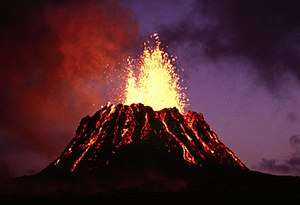Tephriphonolite
Tephriphonolite is a mafic to intermediate extrusive igneous rock in composition between phonotephrite and phonolite.[1] It contains 9 to 14% alkali content and 48 to 57% silica content (see TAS diagram).[2]
Tephriphonolite has been found, for example, at Colli Albani volcano in Italy[3] and in the Asunción Rift of Paraguay.[4]
References
- "Unusual Lava Types". Strongly Alkaline Lavas. San Diego State University. Retrieved 2016-09-11.
- Bailey, Roy A. (2004). "Eruptive History and Chemical Evolution of the Precaldera and Postcaldera Basalt-Dacite Sequences, Long Valley, California: Implications for Magma Sources, Current Seismic Unrest, and Future Volcanism". United States Geological Survey: 17. Cite journal requires
|journal=(help) - Campagnola, S.; Vona, A.; Romano, C.; Giordano, G. (2016). "Crystallization kinetics and rheology of leucite-bearing tephriphonolite magmas from the Colli Albani volcano (Italy)". Chemical Geology. 424: 12–29. doi:10.1016/j.chemgeo.2016.01.012.
- Velázquez, V.F.; Riccomini, C.; de Barros Gomes, C.; Kirk, J. (2011). "The Cretaceous Alkaline Dyke Swarm in the Central Segment of the Asunción Rift, Eastern Paraguay: Its Regional Distribution, Mechanism of Emplacement, and Tectonic Significance". Journal of Geological Research. 2011: 1–18. doi:10.1155/2011/946701.
This article is issued from Wikipedia. The text is licensed under Creative Commons - Attribution - Sharealike. Additional terms may apply for the media files.
